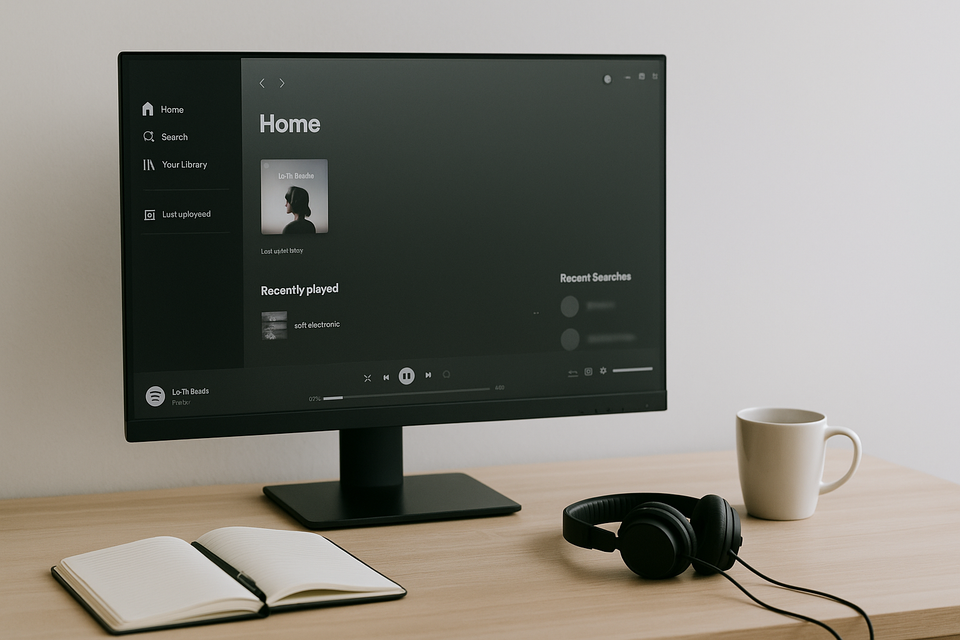Why You Don’t Need to Cheat the Algorithm

Understanding how Spotify’s curation system works – and how to act accordingly
Many independent artists still believe that success on Spotify requires tricks, bots, or aggressive playlisting strategies.
But the reality is: Spotify doesn’t reward manipulation – it penalizes it.
This article offers a practical overview of how the algorithm behind Spotify’s editorial and personalized playlists works, what signals are relevant, and how artists can improve their reach sustainably – without risking penalties or wasting time on unreliable shortcuts.
1. Spotify is not social media
Unlike Instagram, TikTok or YouTube Shorts, Spotify does not reward engagement based on reactions or follower count.
The Spotify algorithm doesn’t care if you have 50 or 5,000 followers – it tracks user behavior during playback.
What matters is not who follows you – but how new listeners react to your track.
Spotify’s key behavioral metrics include:
- Completion rate
- Skip rate (early exits)
- Save rate (added to library)
- Repeat rate (replayed within 24 hours)
- Follower conversion rate
- Playlist adds
- Source of the first streams
Let’s briefly define two of the most misunderstood metrics:
Repeat Rate (within 24 hours)
This refers to how many unique listeners play the same track more than once within a 24-hour period.
Spotify considers this a strong signal of emotional connection – it indicates that the track stuck with the listener. High repeat rates, especially among early organic listeners, are often a trigger for broader algorithmic exposure.
Autoplay or loop tricks don’t count – Spotify recognizes and filters such patterns.
Follower Conversion Rate
This tracks how many new listeners decide to follow your artist profile after hearing one of your tracks.
For example, if 1,000 people hear your song and 30 of them follow you, your conversion rate is 3%. Spotify interprets this as a sign of lasting interest – not just passive consumption.
A good conversion rate usually falls between 2% and 7%. Higher ratios can be common in niche genres.
Spotify’s algorithm isn’t emotional. It identifies patterns. If real people engage deeply with your music – saving, repeating, following – the system considers your track eligible for further visibility.
2. The first 24–72 hours matter – but not in the way many think
There’s a common misconception that you need 1,000+ streams on day one. That’s not accurate.
What you actually need is clean, verifiable, and consistent first-listener data.
If Spotify sees that listeners coming from Release Radar play your track through and save it, that’s a positive signal.
If your streams come from suspicious third-party playlists with high skip rates, it may trigger an internal review or automatic de-prioritization.
What Spotify values:
- Listener behavior, not just volume
- Source transparency
- Gradual momentum, not artificial spikes
3. You don’t need to run ads – but your traffic must make sense
You can grow on Spotify without any paid promotion – but only if your traffic follows a logical pattern.
What Spotify sees as “normal”:
- Plays coming from known sources (your profile, Release Radar, personal links)
- Listeners interacting like real users (saving, following, coming back later)
- Gradual, organic growth over days or weeks
What triggers suspicion:
- Sudden geo-anomalies (unusual countries or IP clusters)
- Large numbers of identical sessions
- Playlist sources with poor user behavior (skips, fast forwards)
- Traffic that looks disconnected from your actual presence as an artist
Spotify’s fraud detection is largely pattern-based. The system is designed to flag anomalies – whether they come from bots or well-meaning mistakes.
4. How to support the algorithm – without pushing it
Some ways to work with Spotify’s system instead of trying to bypass it:
- Submit your track correctly: Use Spotify for Artists to pitch your track early. Choose relevant genre tags and moods.Ensure your metadata is accurate. Use clean artwork that includes the artist name and track title.
- Be cautious with third-party playlists: Don’t pay for placements from unknown curators. Only work with people you trust – or avoid this route altogether.
- Use social media wisely: Smartlinks are fine – but avoid autoplay tricks or forced listening setups.Spread out your traffic across several days instead of frontloading it all on release day.
- Optimize your Spotify profile: Add a short, clear bio. Keep your visuals consistent. Enable Spotify Canvas if it fits your style.These small details help build trust and signal professionalism.
Summary
Clean signals are stronger than short-term tactics
Spotify doesn’t expect you to have a marketing team or a fanbase of 100,000.
It expects your music to generate real interest from real people.
If your track resonates – and your early listener data reflects that – it can be picked up.
You don’t need to cheat the system. But you do need to understand what it actually values.
Sources & References
This article is based on verified information from Spotify’s official resources and long-term insights from artist development and digital distribution practice.
Primary Sources:
Additional Insights:
- Industry interviews and conference panels (e.g. SXSW, Reeperbahn, MusicAlly)
- Practical artist support experience across multiple platforms
View all articles about Spotify
NexaTunes – structured support for independent releases.
Get in touch for more information using our livechat
